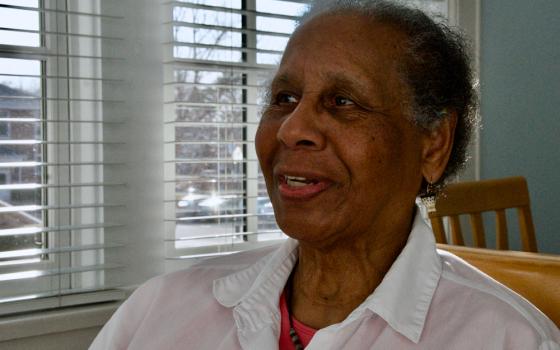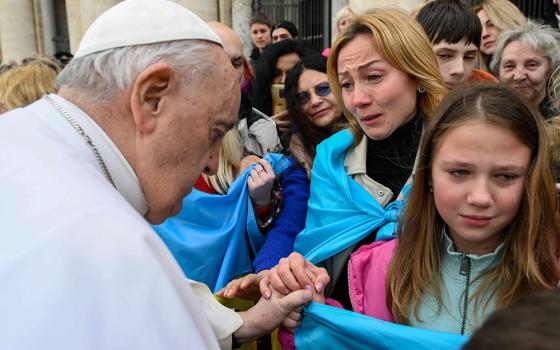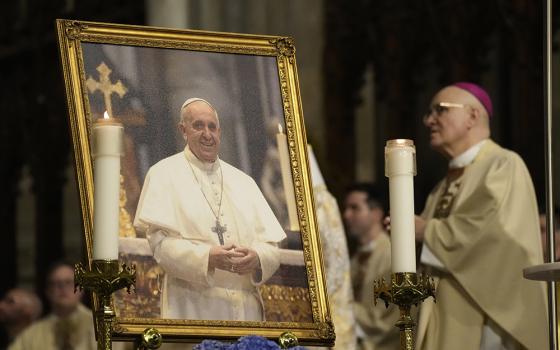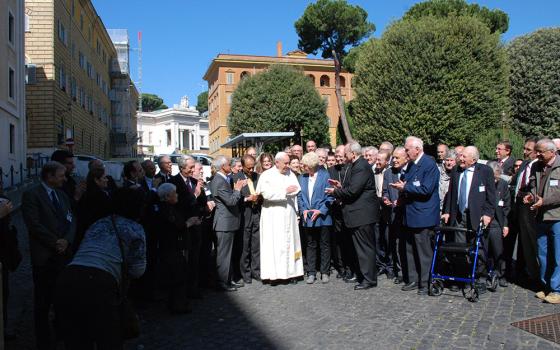
Joel, a Weavers of Hope grant student, with his parents, who are from the indigenous Huichol community in Jalisco, Mexico. His father, Armando, makes bead handicrafts. (Courtesy of Sr. Frances Smith)
In 2002, our village dam broke, flooding the village of Villa García in Zacatecas, Mexico. There was a crack in the dam that burst with the heavy rains. Most of the people had to go to their roofs and wait for help. One mother and baby didn't make it. Animals were all over the place where they hadn't been before. Cars and houses suffered much damage. The governor sent workers to reinforce the creek running through the village to prevent more damage. Families were also advised not to build so close to the creek.
I'd been in this area for about four years and had wondered what it was that called me so clearly to Villa García, a rural village with a population around 8,600. The village consists of 14 rural areas, whereas our parish includes some 22 rural areas. Many of the people live in poverty, as the factories pay little and farm work is temporary. An average salary from factory work is $235 a month, and at times, families are living on $3.50 a day.
Earlier in the year, I'd met Carol Wagner, pastoral minister at St. Thomas More Parish in Austin, Texas, and a member of the Sisters for Christian Community at the time. She had suggested I get in touch with Jack Kern of her parish to see if we could work together. Carol was leading a JustFaith group, and Jack was a participant.
The group was looking for a way to put into practice what they'd learned and experienced during their weeks together, so after the flood, representatives of the JustFaith group and Carol came to see how they could help. I thought helping the elderly or students would be options. The group chose to begin a grant program to help students. This was early in 2003, and back in Austin, they began speaking to parishioners about being sponsors. Thus was born the Weavers of Hope grant program, of which Jack is the president.
Weavers of Hope is a nonprofit organization exempt from federal income tax. The name was chosen because Villa García historically is a village of weavers. While many of the weavers now work in factories, there are still some families doing very fine weaving, and from the beginning, Weavers of Hope has bought fair-price weavings to resell and help fund the program.
Advertisement
I made several trips to Austin to speak to groups about the needs here in Mexico. Several St. Vincent de Paul conferences suggested we begin a conference here. Many who come to our St. Vincent de Paul group looking for help have children who become part of the grant program. Some were victims of the 2002 flood, like Pilar, now a nurse, whose mom lost a leg, and Liliana, now a biologist/chemist who works in a laboratory in Villa García, who came down with cholera.
Every student who is accepted into the program has a story. For example: Alicia, who was learning English with me, discovered she had terminal cancer. Before she died, she asked me to take care of her son, Octavio. Octavio finished his studies as an electrical engineer, and his first project was to open an internet cafe with another Weavers of Hope graduate, Antonio Arvilla, also an electrical engineer, who was caring for his blind father and helping his little brother continue his studies.
There have been significant changes in the field of education since 2003. Students applying at universities at that time were seldom accepted. They didn't have the palanca, that is, connections with someone of influence. Students from the city were given preference. Now, it's mostly tests that determine who will be admitted. Students who have graduated with a degree are helping siblings to continue their studies. For the families in our grant program, it's generally the first in the family to continue studies after high school. Some families have five to seven students studying at the same time, quite a burden for families with a low salary.
One of our first grant students, Jesus Campos, who goes by Chuy, is the youngest of 12 and from the Indigenous community of Paracho in Michoacán. His father was Paracho and his mother was from the Indigenous community of Cheranatzcurin. When I met Chuy, he was living in a room lent to him by Cáritas de Aguascalientes. A full-time student, he was working three jobs and getting three hours of sleep a night. His family never had anyone who went to college, and they discouraged him from doing so. Chuy had been in the seminary — sponsored by a woman in California — but he wanted to be a psychologist and left the seminary. He eventually went on to get his master's degree in family therapy and set up his own institute.
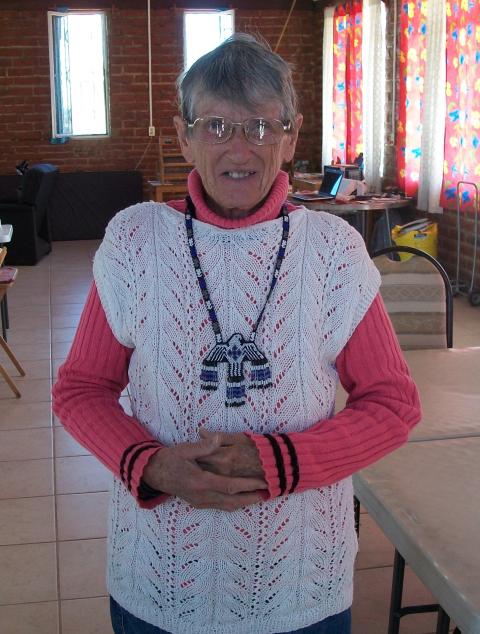
Sr. Frances Smith wears an eagle pendant made by Armando, father to Joel, a Weavers of Hope grant student. This kind of bead work is done by the Huichol people. (Courtesy of Sr. Frances Smith)
Joel, from the indigenous Huichol community in the state of Jalisco, spoke only his Indigenous language when he began school. He eventually had to learn Spanish, English and French in order to complete his university studies. He graduated with two degrees in 2019, one in gastronomy and the other in business administration. His family, in contrast to Chuy's, encouraged him all the way. His own Indigenous community, however, can't understand his getting more education. Joel wants to be a role model for his community and set up a bakery there. In the photo, you see the kind of bead work done by the Huichol people, including an eagle necklace made by Armando, Joel's father.
Presently, Weavers of Hope is sponsoring 75 students from primary grades to university level. At any given moment, there are about 50 students waiting for grants. In April of this year, 120 students will have graduated and have a career.
Eleven years ago, Scarlett Shaffer became the coordinator of Weavers of Hope here in Mexico, planning programs for the parents of the grant students and for the students who meet monthly. She also translates the biannual letters of the students and is one of the pillars of Weavers of Hope.
You can imagine the satisfaction one gets from seeing families receiving grant help radiate hope. They know they are the fortunate ones for having been chosen to enter our program.

Woven handicrafts by members of Weavers of Hope (Courtesy of Sr. Frances Smith)
[Sr. Frances E. Smith is a member of the Sisters for Christian Community. She has ministered in Villa García, Zacatecas, Mexico, for the last 22 years.]




